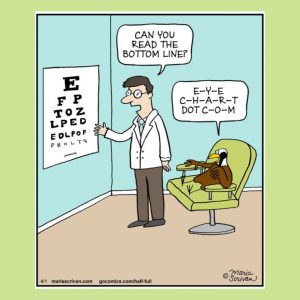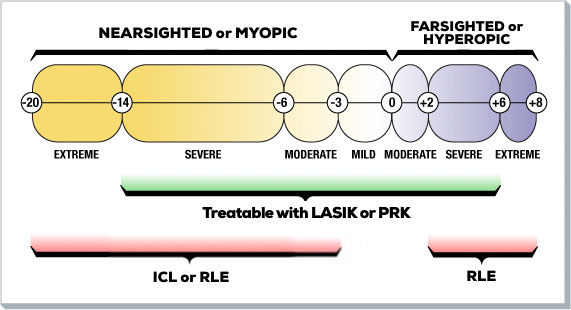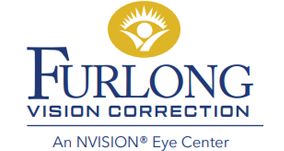 The key to understanding refractive surgery is to understand how the eye works. Once you’ve read about your vision below, check out what your prescription really means at the bottom of this page.
The key to understanding refractive surgery is to understand how the eye works. Once you’ve read about your vision below, check out what your prescription really means at the bottom of this page.
Normal Vision
Sharp, clear vision is the result of light rays passing through the cornea, pupil and lens of the eye and focusing directly on the retina. If the cornea is not round, or is too steep or too flat in relation to the length of the eye, light rays focus either in front of or behind the retina. This results in “refractive errors” such as nearsightedness, farsightedness, and astigmatism. Laser vision correction improves the way the eye focuses light by modifying the curvature of the cornea and re-focusing the light directly on the retina.
Nearsightedness
Nearsightedness, or myopia, occurs when the curvature of the cornea is too steep or the eyeball is too long. With nearsightedness, the eye’s strong refractive power forces the image to be focused in front of the retina, rather than on it. When light focuses in front of the retina, near objects can be seen clearly, but far objects appear blurry. Myopia can be treated by flattening the cornea with LASIK or PRK. An alternative non-laser procedure, Implantable contact lens (ICL) eye surgery, can correct myopia by implanting a special type of lens inside the eye.
Farsightedness
Farsightedness, or hyperopia, is caused when the curvature of the cornea is too flat or the eyeball is too short, forcing light to focus behind the retina. With farsightedness, the eye’s weak refractive power causes far objects to be seen more clearly and near objects to appear blurred. The eyes may have to strain to maintain things in focus. The first appearance of hyperopia is strongly age-dependent; younger patients have much less difficulty with hyperopia. Hyperopia can be corrected by steepening the central cornea with LASIK or PRK.
Astigmatism
Astigmatism occurs when the cornea is irregularly shaped – like a football or a teaspoon – preventing light from converging on the retina. Parts of the image may focus on the retina, while others focus behind it or in front of it. This has the effect of bending light inconsistently and causing blurred or distorted images. Astigmatism can occur alone or in addition to either nearsightedness or farsightedness. Although astigmatism can complicate refractive surgery, it can be effectively corrected with LASIK or PRK.
Higher-Order Aberrations
Several types of visual imperfections, referred to as lower- and-higher-order aberrations, can exist within the same eye and affect both visual acuity and the quality of vision. Lower-order aberrations, like nearsightedness, farsightedness and astigmatism, contribute to approximately eighty percent of refractive errors and affect how much you see. Higher-order aberrations account for the remaining twenty percent of error and affect how well you see. They can be compared to smudges or spots on your glasses and have been linked to halos and glare that cause vision problems at night. In the past, higher-order aberrations have not been treatable by conventional laser vision correction procedures. Now, Contoura® Vision Topography-Guided LASIK can quantify and correct these higher-order aberrations.
Presbyopia
As people get older, the lens inside their eye changes and is no longer able to focus on images up close. This condition is called presbyopia or “reading glasses syndrome.” People with this condition may experience eye fatigue when reading in poor light or at the end of the day, have trouble changing their focus from distance to near, or need to constantly reposition reading material in an attempt to find the right focus. This loss of elasticity in the lens becomes apparent when near vision starts to get blurry somewhere between the ages of 40 to 50. This happens to everyone, regardless of whether they have ever worn glasses before. The symptoms of presbyopia are sometimes confused with those of farsightedness, but they are not the same and the treatment for each is different.
Traditionally, presbyopia has been corrected by wearing reading glasses. Some people have avoided reading glasses for many years, however, by having their vision corrected with LASIK or PRK and a technique called monovision. Additionally, presbyopic vision can also be corrected with non-laser vision procedures like Refractive Lens Exchange Surgery (RLE) that help reduce dependence on glasses or contacts.
Monovision
 Monovision is an option for people with presbyopia where each eye is adjusted to have a slightly different focus point. One eye will see things close up, the other eye will see things farther away – and the brain will integrate the visual information from both and filter out any blur. With monovision, you do not need to make any conscious adjustments in how to see and the brain usually adjusts within six to eight weeks.
Monovision is an option for people with presbyopia where each eye is adjusted to have a slightly different focus point. One eye will see things close up, the other eye will see things farther away – and the brain will integrate the visual information from both and filter out any blur. With monovision, you do not need to make any conscious adjustments in how to see and the brain usually adjusts within six to eight weeks.
Monovision refractive surgery is not a cure for presbyopia. It simply “re-sets” the clock for near vision, giving you an additional 5 to 10 years without the need for reading glasses for most tasks. Even with monovision, however, there may be some situations (such as night driving in unfamiliar areas) where you might require glasses.
The decision to have monovision refractive surgery is dependent on your age, profession, hobbies and desires. People who need to see very well at distance (e.g., pilots or nighttime truck drivers) may not be the best candidates for monovision. It’s also not recommended for people under 40 who are not yet feeling the effects of presybopia because the benefits will not be realized for many years. It is possible that surgeries that directly cure presbyopia will become available in the future.
It is a good idea to simulate monovision on a trial basis to see if you are comfortable with your eyes focusing at different distances. We can help you do this by fitting you with contact lenses or trial eyeglass frames adjusted to reflect the different possible corrections. This will give you a good idea of whether monovision is right for you.
Monovision has been used successfully for over 20 years. Refractive surgery patients can achieve monovision either with LASIK or PRK. If monovision testing is inconclusive as to whether you would benefit from the procedure, RLE Surgery may also be an option.
| Vision correction surgery gets rid of glasses for most prescriptions | ||
| Which of these is true for you? | You might benefit from monovision with LASIK / PRK | You might benefit from IOL Surgery |
|---|---|---|
| I only need reading glasses | 65 and under | |
| I had LASIK before and now need reading glasses | 65 and under | |
| I use bifocals or progressive lenses | 50 and under | Over 50 |
| My prescription is outside the LASIK parameters | Over 50 | |
| I am noticing impaired night vision, depth perception and/or color distortion | All ages | |
Understanding Your Prescription
When you go to the eye doctor for glasses or contact lenses, the doctor measures your eyes and records these readings in a prescription. Patients have a tendency to remember that they are “20/400” or “20/1000,” but these numbers simply refer to the line on the eye chart that you are able to read. Doctors use a more precise set of numbers to measure your prescription.
If you look at your prescription, either for glasses or contact lenses, you can get a fairly good idea as to the type of refractive error that you have, as well as its severity. Generally, prescriptions appear as a series of three numbers and might look something like this:
| Example Prescription | |||
| RX | SPH | CYL | AXIS |
|---|---|---|---|
| RIGHT EYE | -2.50 | -1.00 | 180 |
| LEFT EYE | -4.25 | -1.25 | 93 |
The first number (sphere) indicates the curvature of the cornea. A negative number means that you are nearsighted with a cornea that is too steep. A positive number means that you are farsighted with a cornea that is too flat. The closer the number is to zero, the less severe the prescription. The second number (cylinder) indicates the amount of astigmatism you have. The further the number is from zero, the more pronounced the astigmatism. A value up to 2.50 is considered moderate; anything above 2.50 may be considered severe. The third number (axis) reflects the orientation of your astigmatism.
LASIK or PRK can treat the widest range of prescriptions from -14 through +6. For those patients with prescriptions outside this range, we offer additional vision correction options including ICL or RLE. The graphic below depicts the treatment options based on prescriptions.

Range of Prescription
